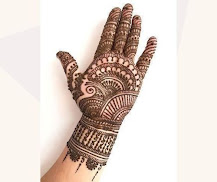WoW Flipkart Zivame
Mehndi – a symbol of joy & celebration!
In India, festivities and marriage celebrations are not complete without mehndi. Mehndi plays an important role in marriages, festivals and other ceremonies. It is considered auspicious to apply mehndi on your hands and feet. Mehndi is a form of body art and temporary skin decoration originating in ancient India, in which decorative and creative designs are created on a person's body, using a wet paste, created from the powdered dry leaves of the henna plant.
Mehndi is derived from the Sanskrit word mendhikā. The application of mehndi and turmeric is described in the earliest Hindu Vedic ritual books. It was originally used for only women's palms and sometimes for men, but as time progressed, it was more common for men to wear it too. Staining oneself with turmeric paste, as well as mehndi, are Vedic customs, intended to be a symbolic representation of the outer and the inner sun. Vedic customs are centered on the idea of awakening the inner light. Traditional Indian designs are representations of the sun on the palm, which, in this context, is intended to represent the hands and feet. Mehndi has a great significance in performing classical dance like Bharatnatyam.
Mehndi in Indian tradition is typically applied during weddings and Hindu festivals like Karva Chauth, Vat Purnima, Diwali, Bhai Dooj, Navraathri, Durga Pooja and Teej. Muslims in South Asia also apply mendh during Muslim weddings, festivals such as Eid-ul-Fitr and Eid-ul-Adha. During Hindu festivals, normally women apply mehndi to their hands and feet and sometimes on the back of their shoulders too, as men apply it on their arms, legs, back, and chest. And women, it is usually drawn on the palm, back of the hand and on feet, where the design will be clearest due to contrast with the lighter skin on these surfaces, which naturally contain less of the pigment melanin. Some even use it to dye their grey or white hair. But it tends to look brown reddish colour.
Due to the desire for black tattoo, some people add the synthetic dye p-Phenylenediamine (PPD) to henna to give it a black colour. PPD may cause severe allergic reactions and was voted Allergen of the Year in 2006 by the American Contact Dermatitis Society.
Mehndi is an auspicious ceremonial art form which originated in the ancient Indian subcontinent. On the mehndi day, it is typically applied during weddings - for Hindu and Muslim brides. In Rajasthan, the grooms are given designs that are often as elaborate as those for brides. In Assam, apart from marriage, it is also applied by unmarried women during Rongali bihu. Muslims in Afghanistan also use it as an indication of coming of age. In the Middle East and Africa, it is common for women to apply henna to their fingernails and toenails and on their hands.
In Pakistan, the mendhi ceremony is referred to Rasm-e-Heena and is often one of the most important pre-wedding ceremonies, which is celebrated by the bride's family. In Bangladesh, the mendhi ceremony has traditionally been separated into two events; one organized by the bride's family and other one, by the groom's family. Mehndi ceremonies are also popular outside the Indian subcontinent amongst the South Asian community and abroad wherever people from the Indian subcontinent are settled. These are known hot spots for lavish mendhi celebrations and big fat weddings and celebrations.
Also read:
Big impact with a small budget!
Make Kindle Your Personal Library!
Pakistanis must learn the truth?
Indian’s in the Worlds’ Wealthiest list!
MyPost
The World’s Biggest Spenders on R&D
Amazon emerged as the biggest spender on research and development in 2020 with R&D investing totaling $43 billion. Companies with the highest R&D investment expenditure in 2020 are as follows -Alphabet with $27.6 billion and Huawei with $22 billion were second and third in the list. Next on the list were Microsoft with $19.3 billion, Apple with $18.8 billion, Samsung with $18.8 billion and Meta with $ 18.5 billion.
Companies with the highest R&D investment share from net sales - For Amazon it was 11% of net sales, Alphabet, it was 15% of net sales, Huawei, it was 16% of net sales, Microsft, it was 13% of net sales, Apple it was 18.8% of net sales, Samsung, it was 18.8% of net sales and Meta, it was 21% of net sales.
..........................................................................................
Picture Post
 |
| Shree Padmanabha Swamy Temple, Kerala, India |
To
book an ad or an announcement on this blog.
WhatsApp: 91 9969154602 Email: akn929@yahoo.com
..........................................................................................
*Your
comments are welcome. We value them, to make the blog better.
*Guest
writers are welcome. Tell us about the subject. Get in touch.
*Please share this blog with your friends.
..........................................................................................
Recommended
viewing:
Anil
Naik - YouTube Channel
https://youtube.com/channel/UCwo9Re44827w8c6QPmxlnug
Please
like, comment and Subscribe.
..........................................................................................
If
you feel that Aneela Nike Post is making a difference to your life, do take a
minute to consider a comment or contribution. We would also value your
suggestions as how to make ourselves more relevant to you. Please write to akn929@yahoo.com to give your
valuable feedback.
 |
| Order now- ayurvedclinic.com |













মেহেদি ডিজাইন ২০২২ | নতুন মেহেদি ডিজাইন ছবি
ReplyDeleteThanks for your message but I am unable to read it. If you wish to promote your mendhi design work, you can put a banner ad on the blog.
ReplyDeleteBe it on the occasion of marriage or Eid, everyone gets excited with the joy of applying mehndi. Women like to apply mehndi for every noble function except marriage.
ReplyDeleteমেহেদি ডিজাইন
I read your blog and find it to be interesting. if you're interested in learning more about henna and other details regarding bridal mehndi artist near me.
ReplyDelete